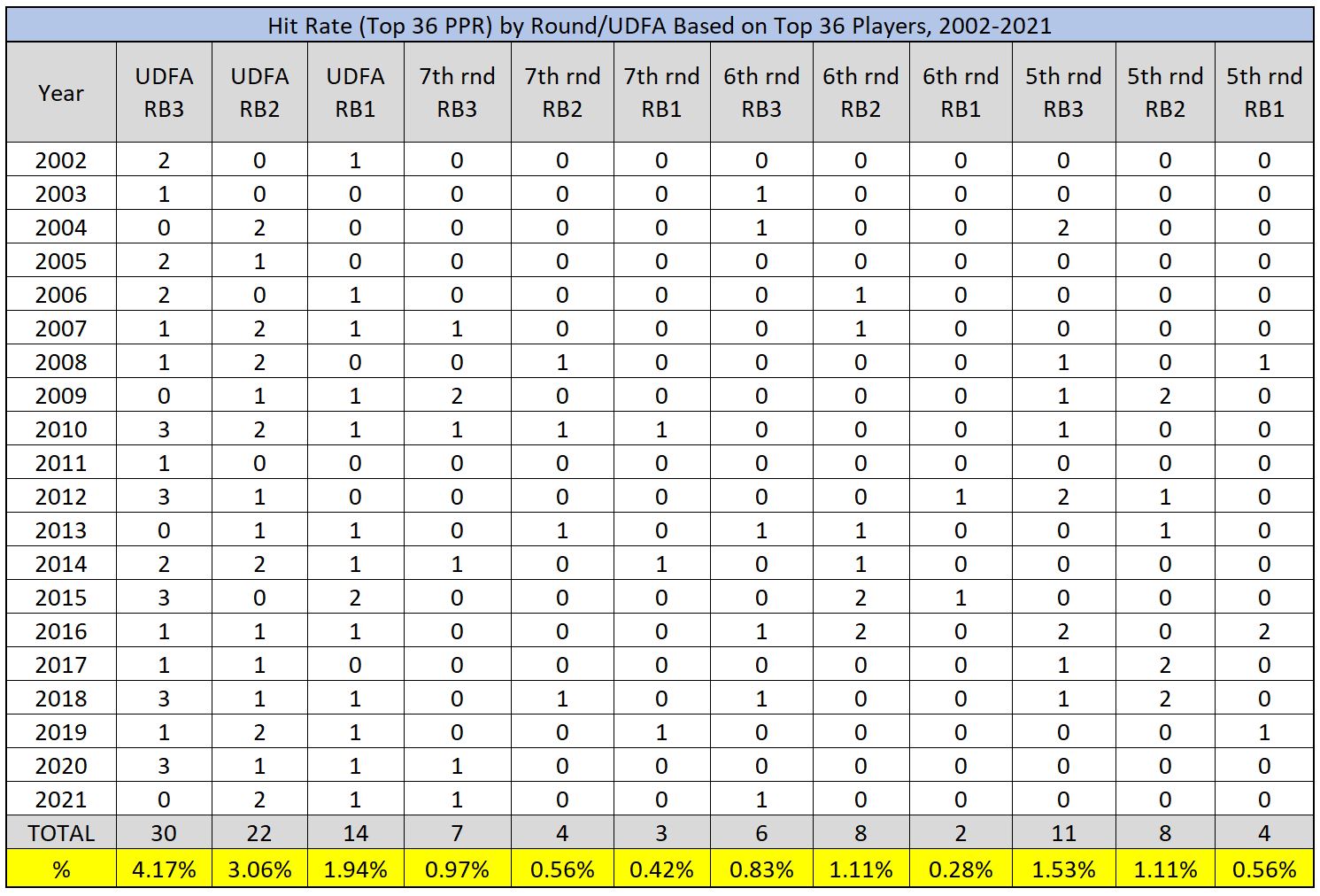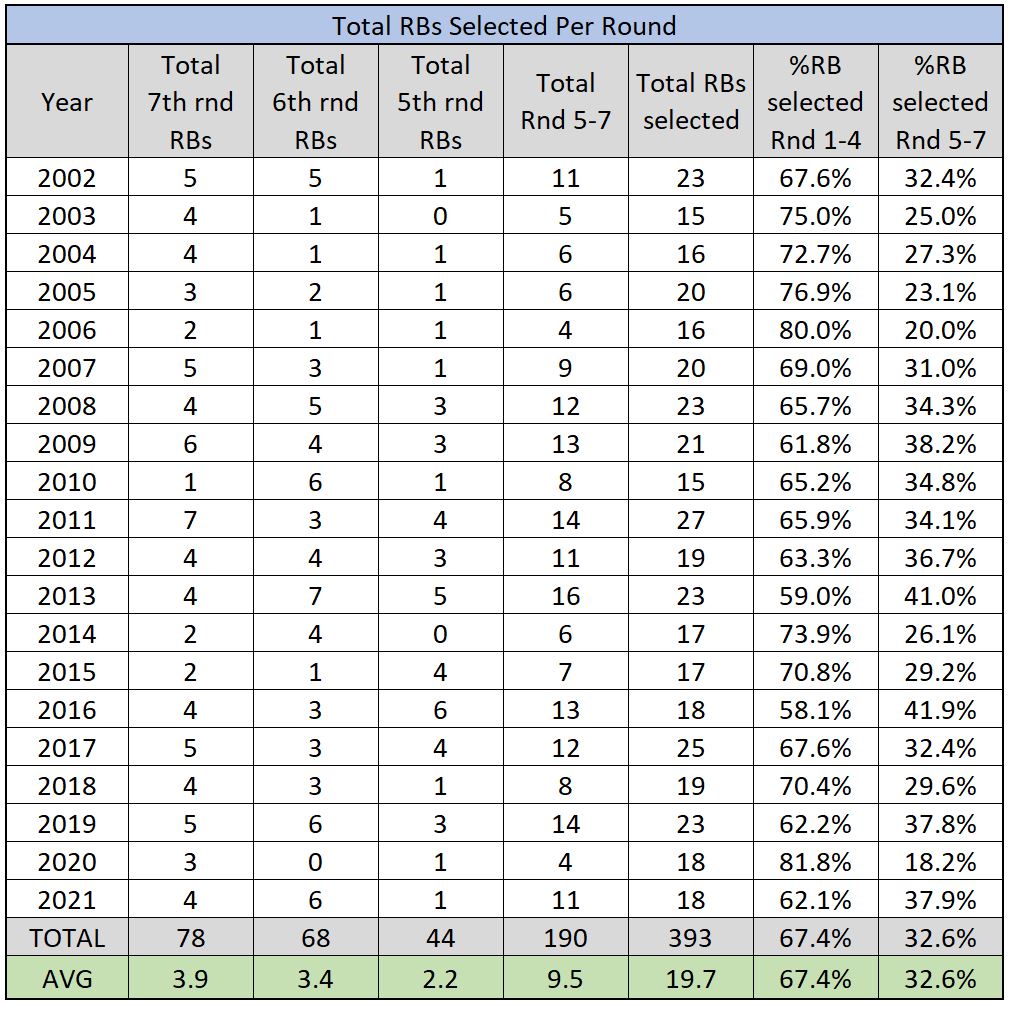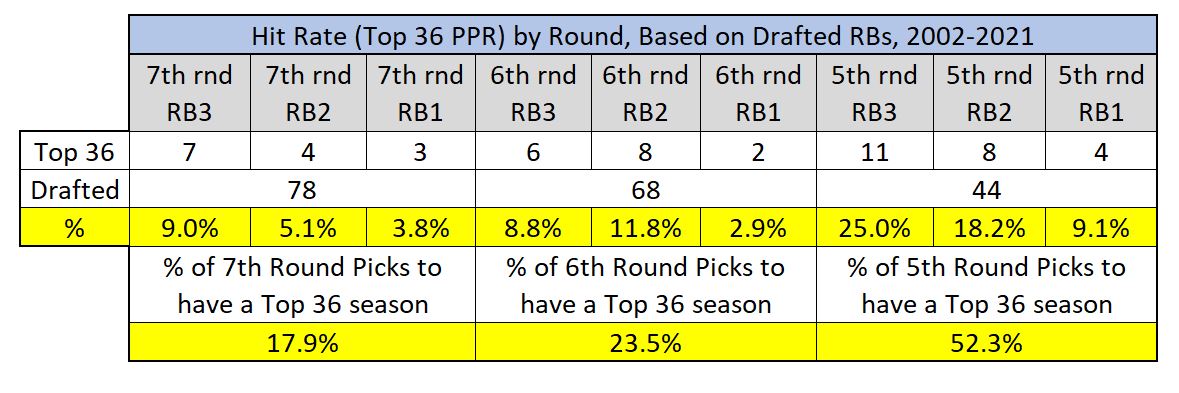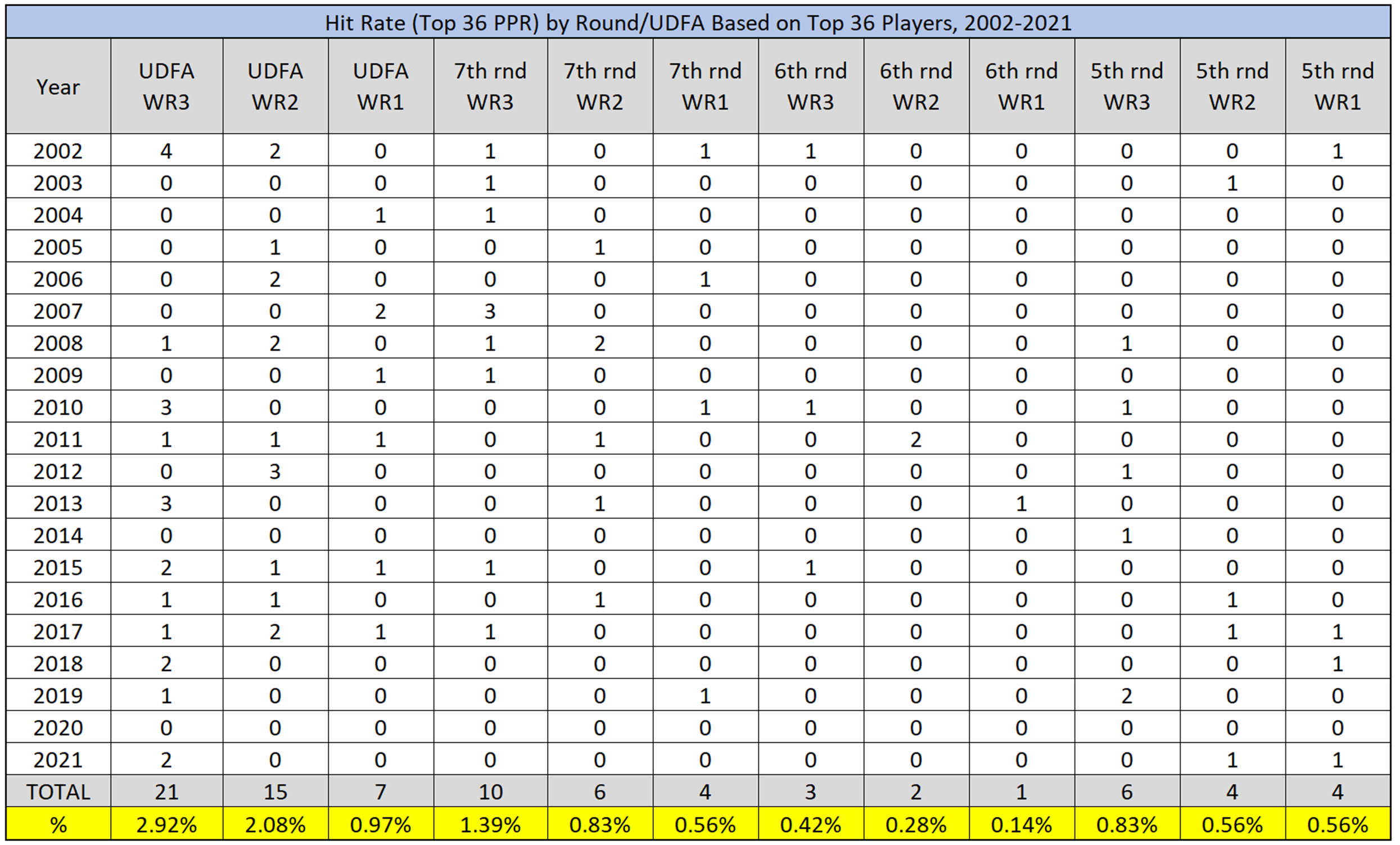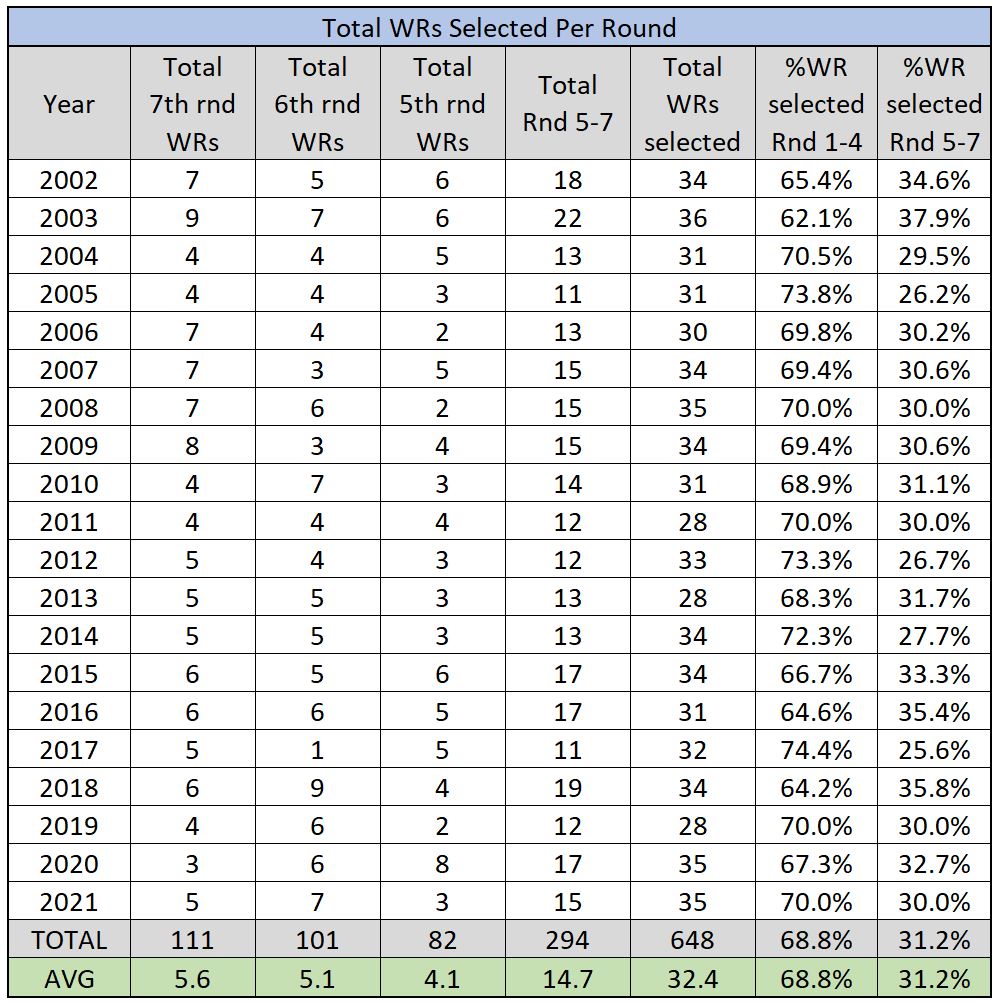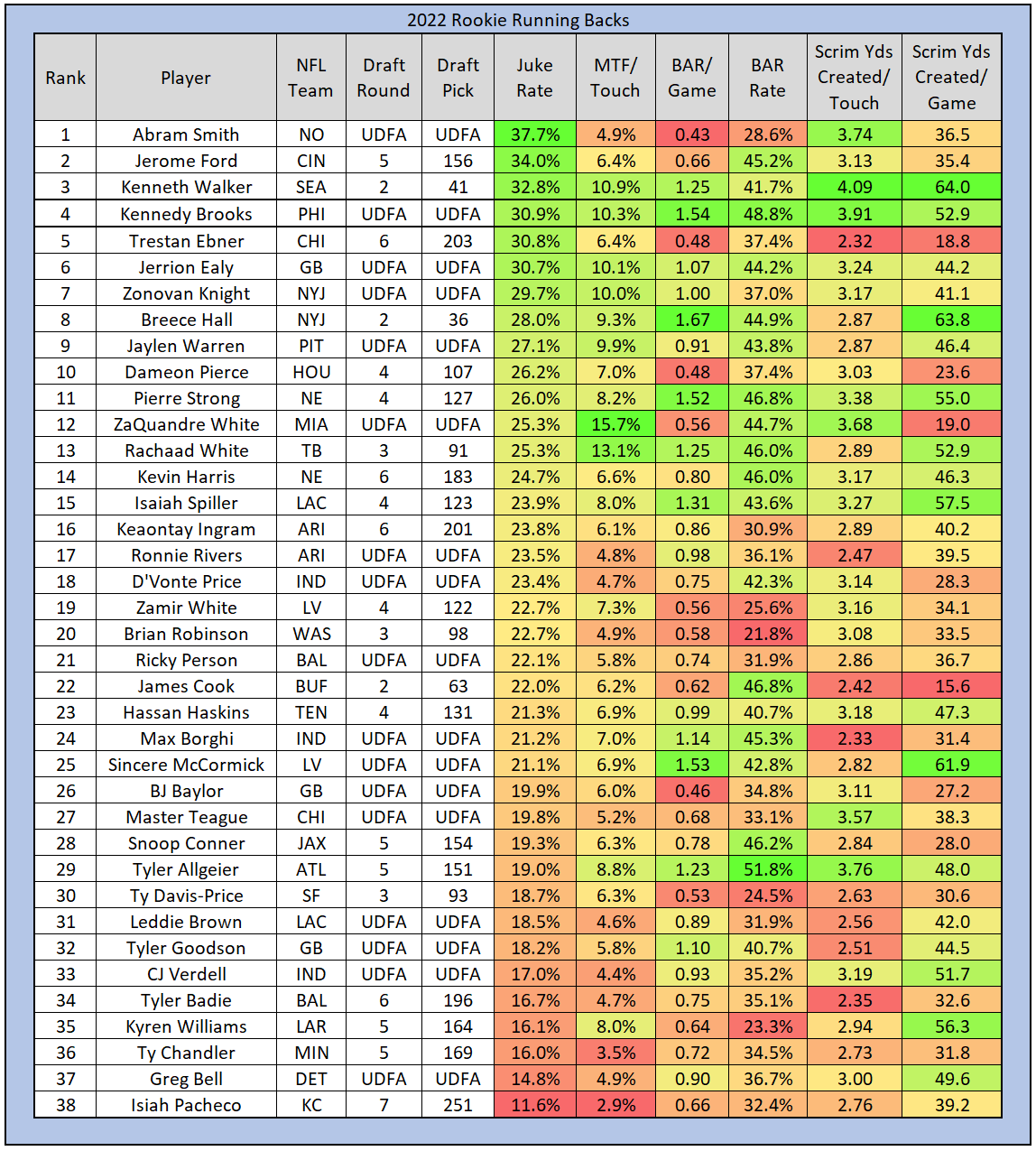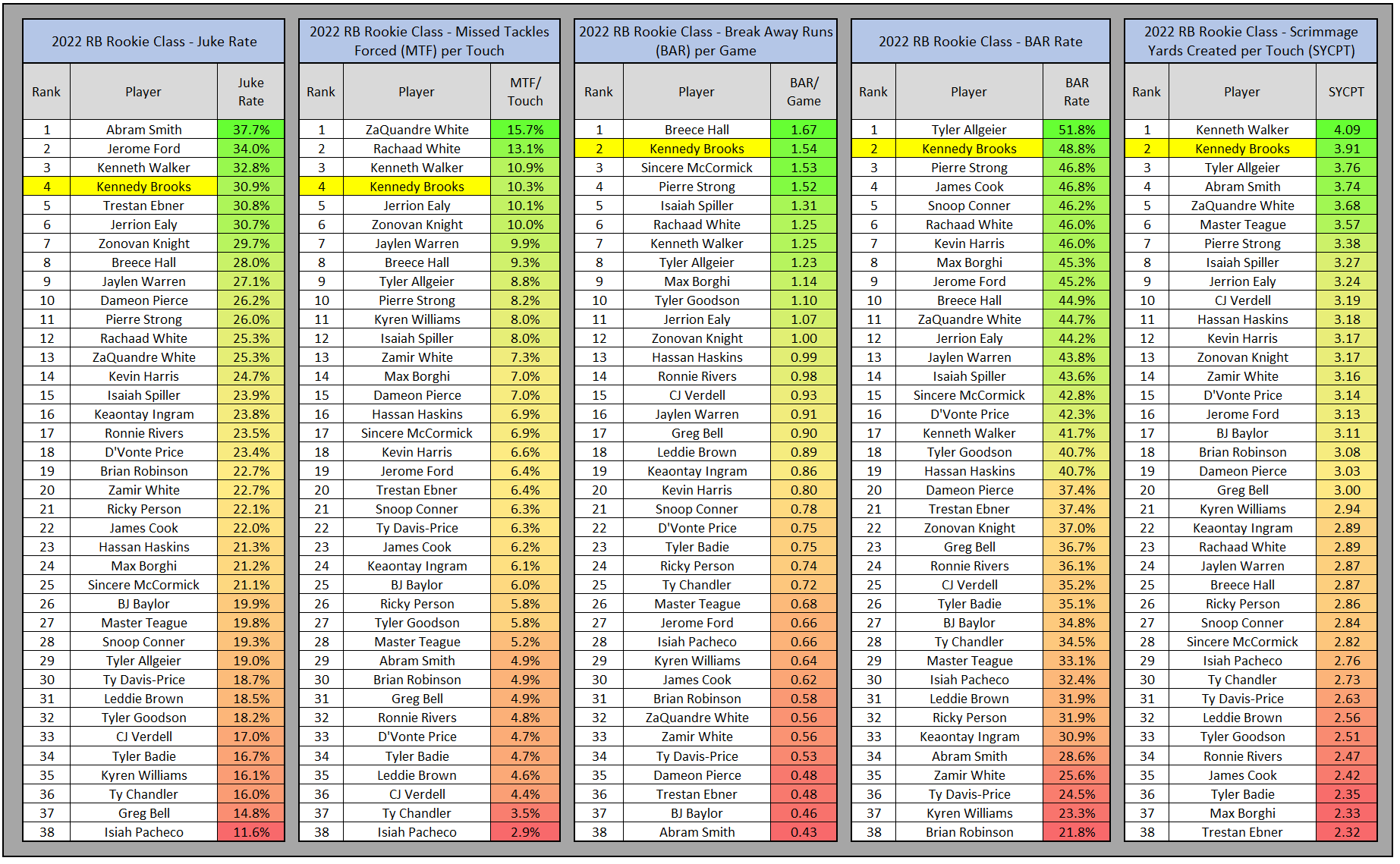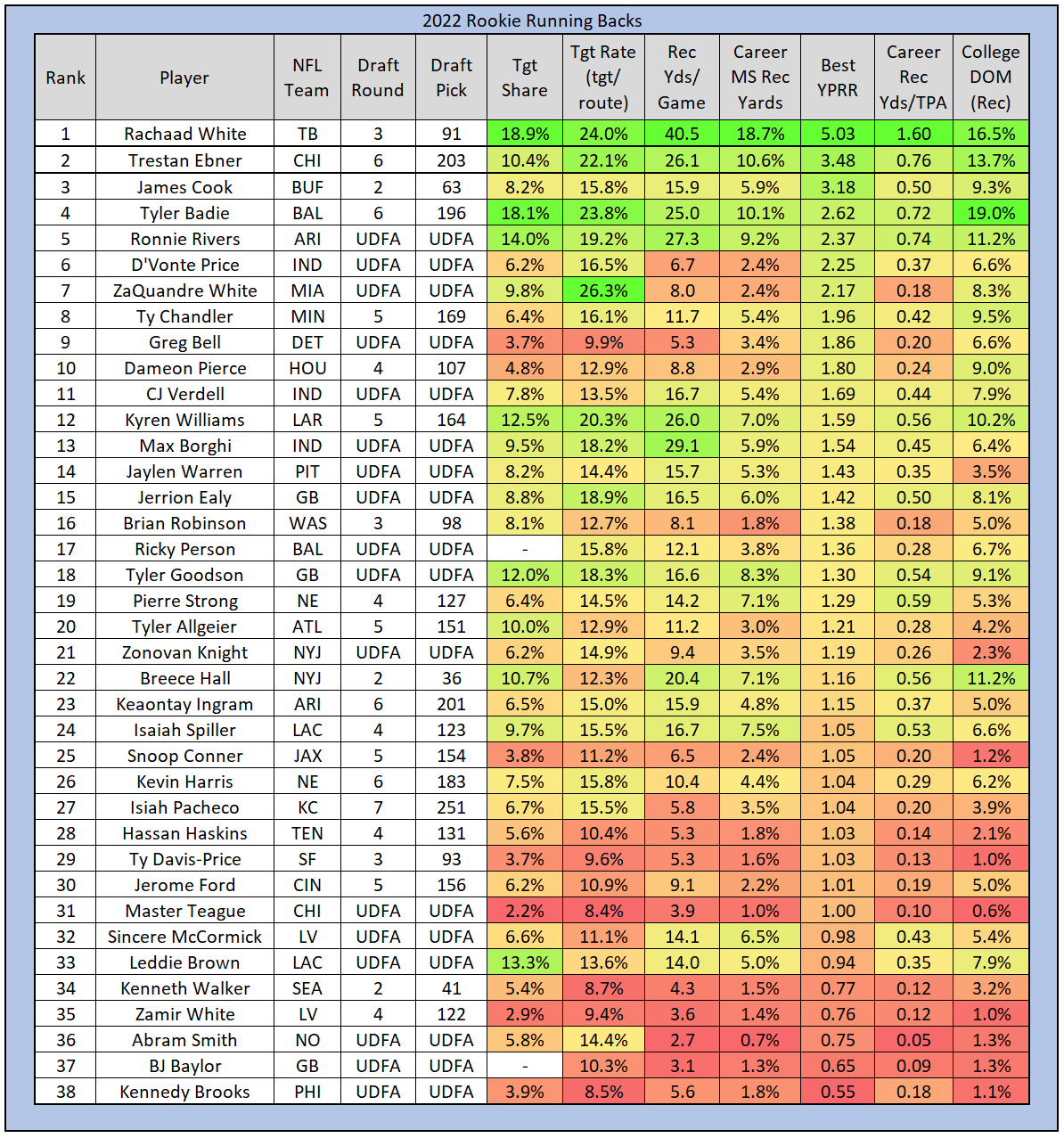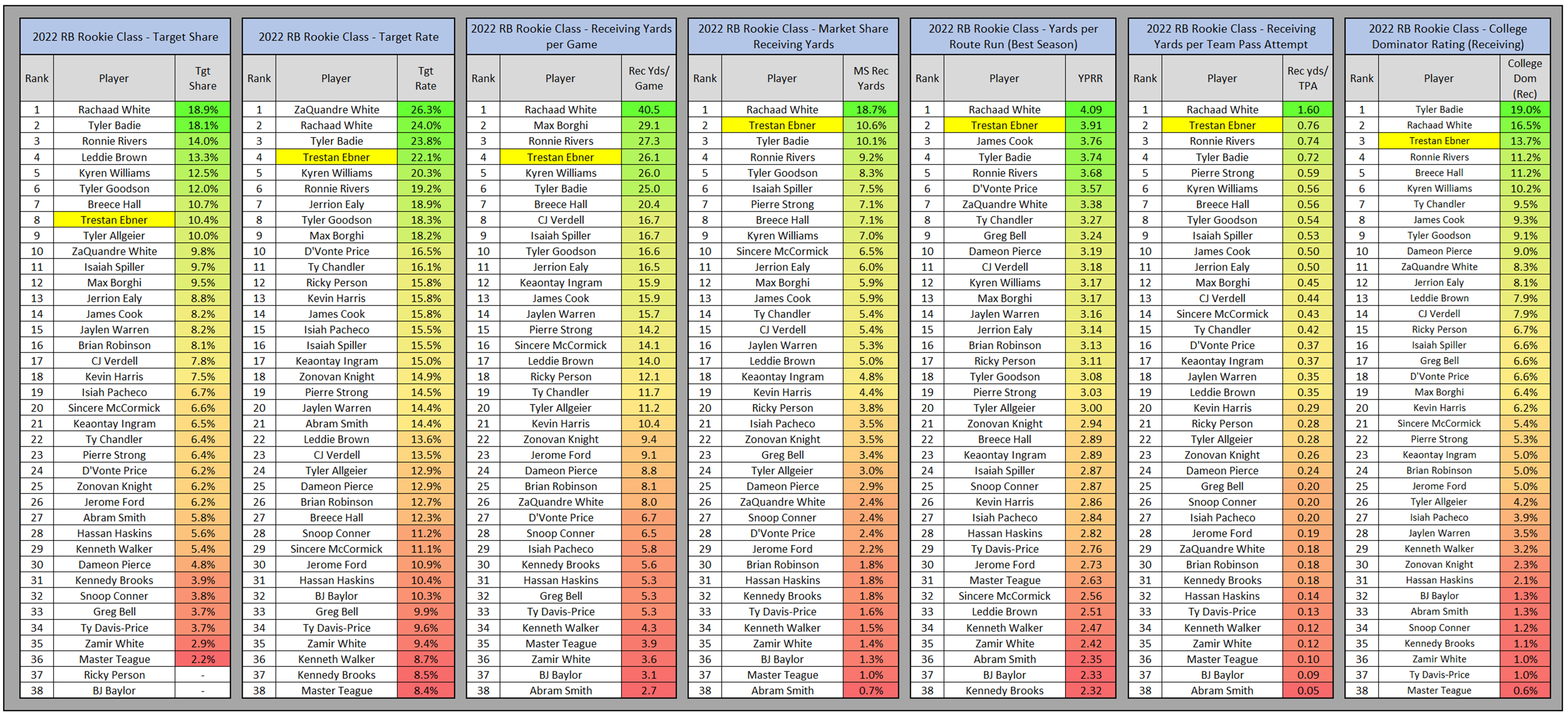Fantasy Football Sleepers 2022
The term “sleeper” in fantasy football has lost some of its luster over the last handful of years. With the explosion of fantasy football content and always improving access to information, there are not a lot of unknown or under-analyzed players in the NFL these days. For a while now I have viewed a “sleeper” simply as a player who has the potential to outproduce their draft price, better described by the word “value.” Regardless of what the word means to you, it is not going anywhere. “Sleeper” content is some of the most popular content produced in our never-ending quest to gain an edge on our league mates.
One place the more unknown theme of the term still exists is with incoming rookies, especially later round and undrafted rookies, who are still not well known outside of deep dynasty and devy formats. In this article, I will look closely at two rookies RBs and give my reasoning why each has sleeper potential, both for very different reasons.
It may seem like a futile effort, trying to predict potential fantasy football success for players passed on by every NFL team for multiple rounds or the entire draft. But there is precedent behind the search. Players like James Robinson (undrafted), Elijah Mitchell (6th round), Stefon Diggs (5th round), Antonio Brown (6th round), Doug Baldwin (undrafted), Tyreek Hill (5th round), and a host of other players went on to find fantasy success from a late-round or undrafted starting point. It is just enough historical precedent to lure someone like me into spending many hours searching for the next one.
Before I dive deep into two 2022 rookie RB sleepers, I would like to provide some context for this process. I am well aware that the odds of me getting any of these players “right” are not fantastic, but I wanted to quantify those odds so we all know what we are getting ourselves into when we go down the deep sleeper rookie rabbit hole. This isn’t to steer you away from the effort, but rather to provide some reality to what this has looked like historically, specifically for RBs and WRs.
Win Your Fantasy League!
Become a member at FantasyData and get access to the industry’s best fantasy football subscription available!
THE HISTORY OF LATE-ROUND FANTASY SUCCESS
For this exercise, I looked at every NFL draft since 2002, up through the 2021 draft. Granted the numbers are a tad skewed due to the last few draft classes only having the opportunity to achieve the thresholds I’m setting for a few seasons, but not enough to significantly impact the results.
I also looked at the fantasy football Top 36 total points rankings (PPR format), for both RBs and WRs, from 2002 to 2021 as well (courtesy of fantasydata.com). I charted how often a player, drafted in rounds 5-7 (what I am calling “late round”) or undrafted, finished inside the Top 36. I then broke that down further by looking at how many times it was an RB3/WR3 finish (Ranked 25-36; 12-team format), RB2/WR2 finish (Ranked 13-24), and an RB1/WR1 finish (Ranked 1-12). I did not count repeat Top 36 seasons for individual players, as the purpose is to shed light on how often late-round and undrafted players crack the Top 36 even once.
LATE ROUND/UNDRAFTED RUNNING BACKS
The following are the results for RBs, showing the total number of players for each category, out of all players who made the Top 36, from 2002-2021:
The data is explained as follows:
Since 2002:
- 4.17% of RBs who finished as RB25-RB36 were undrafted.
- 3.06% of RBs who finished as RB13-RB24 were undrafted.
- 1.94% of RBs who finished as RB1-RB12 were undrafted.
- 0.97% of RBs who finished as RB25-RB36 were 7th-round picks.
- 0.56% of RBs who finished as RB13-RB24 were 7th-round picks.
- 0.42% of RBs who finished as RB1-RB12 were 7th-round picks.
- 0.83% of RBs who finished as RB25-RB36 were 6th-round picks.
- 1.11% of RBs who finished as RB13-RB24 were 6th-round picks.
- 0.28% of RBs who finished as RB1-RB12 were 6th-round picks.
- 1.53% of RBs who finished as RB25-RB36 were 5th-round picks.
- 1.11% of RBs who finished as RB13-RB24 were 5th-round picks.
- 0.56% of RBs who finished as RB1-RB12 were 5th-round picks.
You can see the odds of these later-round and undrafted RBs finding fantasy success are low. The reason the numbers are slightly higher for undrafted players is that pool of players is much larger than the pool of players drafted in each round.
However, this is not the only angle from which to look and doesn’t take into account the sample size of late-round RBs. It is based on the total number of Top 36 players since 2002 (720) as the denominator.
What about the following question: How often do the 7th round (or 6th, etc.) RBs achieve a Top 36 fantasy season? This angle paints a far less grim picture for potential success as it includes the more appropriate sample size, with the total number of RBs drafted in that round as the denominator. For this, I started by simply charting the number of total RBs selected in rounds 5-7 each year since 2002.
NOTE: For this next part, I am not including undrafted players, as that information is difficult to acquire in the same 2002-2021 time frame.
We then have answers to the question above. Again, this is not factoring in multiple Top 36 seasons by the same player. Only the first one counts. Looking at which late-round RBs not only made the Top 36 but repeated that performance should not be ignored, but it is not part of the purpose here.
You can see the results here:
So, phrasing the question in this form: “What has been the success rate of 7th round RBs in making the Top 36 since 2002?”, gives us the following:
- Since 2002, 17.9% of RBs drafted in the 7th round have achieved a Top 36 fantasy season.
- Since 2002, 23.5% of RBs drafted in the 6th round have achieved a Top 36 fantasy season.
- Since 2002, 52.3% of RBs drafted in the 5th round have achieved a Top 36 fantasy season.
You can also see how those percentages are divided up between RB3, RB2, and RB1 finishes.
LATE ROUND/UNDRAFTED WIDE RECEIVERS
The following are the results for WRs, showing the total number of players for each category, from 2002-2021:
The data is explained as follows:
Since 2002:
- 2.92% of WRs who finished as WR25-WR36 were undrafted.
- 2.08% of WRs who finished as WR13-WR24 were undrafted.
- 0.97% of WRs who finished as WR1-WR12 were undrafted.
- 1.39% of WRs who finished as WR25-WR36 were 7th-round picks.
- 83% of WRs who finished as WR13-WR24 were 7th-round picks.
- 0.56% of WRs who finished as WR1-WR12 were 7th-round picks.
- 0.42% of WRs who finished as WR25-WR36 were 6th-round picks.
- 0.28% of WRs who finished as WR13-WR24 were 6th-round picks.
- 0.14% of WRs who finished as WR1-WR12 were 6th-round picks.
- 0.83% of WRs who finished as WR25-WR36 were 5th-round picks.
- 0.56% of WRs who finished as WR13-WR24 were 5th-round picks.
- 0.56% of WRs who finished as WR1-WR12 were 5th-round picks.
Like with RBs (and omitting undrafted players for this part), the WR hit rate looks better when looking at Top 36 finishes based on all WRs drafted in rounds 5-7 since 2002, rather than all WRs who have made the Top 36 since 2002.
Phrasing the question in this form: “What has been the success rate of 7th round WRs in making the Top 36 since 2002?”, gives us the following:
- Since 2002, 18.0% of WRs drafted in the 7th round have achieved a Top 36 fantasy season.
- Since 2002, 5.9% of WRs drafted in the 6th round have achieved a Top 36 fantasy season.
- Since 2002, 17.1% of WRs drafted in the 5th round have achieved a Top 36 fantasy season.
Seventh-round WRs have a Top 36 hit rate virtually the same as RBs. However, the hit rate for 5th and 6th round RBs has been significantly higher than for 5th and 6th round WRs.
Both repeat performances and which season these late-round players made the Top 36 are also important pieces of this puzzle, and I will be focusing on those aspects in a future article. For now, this study helps to provide a quantifiable reality from which to approach your strategy with late-round and undrafted players, hopefully with more realistic expectations.
DEEP SLEEPER
Kennedy Brooks (RB, Philadelphia Eagles)
Kennedy Brooks falls in the undrafted category, as he did not find an NFL suitor during the seven rounds of the 2022 NFL Draft. However, he was signed relatively quickly following the draft by the Philadelphia Eagles.
Brooks played for the University of Oklahoma his entire college career, amassing 1,000+ rushing yards in each season he played. Brooks ended up opting out of the 2020 season due to COVID-19, but finished strong in his final year, rushing 198 times for 1,253 yards and 13 TDs. Throughout his time as a Sooner, Brooks averaged 7.0 yards per carry on 472 total rushing attempts.
He was a one-dimensional RB, totaling only 37 targets over three seasons (1.0 targets per game played). Brooks is not a burner, clocking a pedestrian 4.59 40-yard dash time at the NFL Combine, and he notched middle-of-the-pack numbers across the board in metrics like shuttle time, 3-cone drill, broad jump, vertical jump, Relative Athletic Score (RAS), burst score, speed score, and agility score. A decent college rushing profile at a Power 5 school with average physical and athletic metrics and very little evidence of receiving potential. Hence, it’s not that surprising he went undrafted.
But let’s go back to one statistic that jumped out to me: 7.0 YPC on 472 attempts. That is an impressive average on that many rush attempts. He is not very fast, and possesses relatively average athleticism, so what’s going on here? Other than YPC, Brooks did excel in some important statistics:
Among ’22 RB prospects, only two RBs averaged the following in their college career:
📍30%+ juke rate
📍30%+ evaded tackles/touch
📍1.50+ breakaway runs/game
📍3.50+ yards created/touch1. Kenneth Walker
2. Kennedy BrooksNonexistent receiving, but both are excellent runners.
— Scott Rinear (@MunderDifflinFF) April 4, 2022
Running backs who don’t rely on speed need to be patient, elusive, make would-be tacklers miss, and break tackles. Brooks was top 5 among the current rookie RB class across metrics that measure these skills. Add to that Brooks’ top 5 Break Away Run (BAR; runs of 20+ yards) numbers, another relatively predictive statistic, and it’s a recipe for a potential steal by the Eagles.
The following is a table showing the 2022 RB rookie class and how each player fared in these statistics:
Below is the same data as the table above, but showing the rankings, 1-38, for each statistic:
Miles Sanders is entering a contract year and I doubt remains with Philadelphia after the 2022 season. The Eagles seemingly haven’t been able to figure out how to use Sanders, who has been a very efficient RB when given the opportunity but has also battled injuries. Boston Scott was re-signed to a one-year deal for 2022. The Eagles’ 2021 5th round pick, Kenneth Gainwell, projects to be the pass-catching back in the Eagles offense, but with the shaky future of the other RBs, the Eagles are lacking that “hammer” in their running game, a role they tried to fill in 2021 with Jordan Howard. Brooks reminds me of a slightly smaller but more elusive version of Jordan Howard. At 5’11” and 209 pounds, Brooks is slightly smaller than the ideal size for that hammer/grinder/short-yardage/goal-line role, but his skill set sets up the potential for a two-down back who will see red zone and goal-line work, which would combine nicely with the rushing roles likely filled by Gainwell and QB Jalen Hurts.
Brooks is more of a sleeper for 2023 and dynasty formats, as he likely won’t see enough work his rookie season to be fantasy relevant. We are talking about an undrafted player, so there are no guarantees he even makes the team. But I can see a range of outcomes for Brooks carving out a decent rushing role with the Eagles, and potentially being another late-round/undrafted RB who cracks the Top 36.
Trestan Ebner (RB, Chicago Bears)
I’ll be honest, I didn’t know much about Trestan Ebner before the draft. He wasn’t on many of the pre-draft Top 25-30 RB lists. The Chicago Bears selected Ebner in the 6th round of the 2022 NFL Draft, and he now finds himself on a team without a legitimate pass-catching RB. And that is where Ebner’s skill set lies, as a pass-catcher.
Ebner is on the older side of the rookie scale, having played five full seasons at Baylor, which is a knock in dynasty formats. But this is about deep sleepers, so we go into it knowing there will be cons on the pros and cons list. One of those cons is his college rushing profile, averaging only 48.8 rushing attempts for 222.8 rushing yards per season before his final season (148 attempts for 799 yards in 2021). There was not anyone to speak of ahead of him on the Baylor depth chart, so this tells me he’s a change of pace, pass-catching back. That was his role at Baylor, and I think that will be his role in the NFL, similar to my outlook for James Cook.
Also similar to Cook, Ebner is very fast (4.43 40-yard dash time), and I think Ebner is one of the better pass-catching RB prospects of this draft class, and his deeper numbers support that stance. The following is a table showing the 2022 RB rookie class and how each player fared in multiple receiving statistics:
Below is the same data as the table above, but showing the rankings, 1-38, for each statistic:
You can see where Ebner ranked compared to the other 2022 rookie RBs in these pass-catching profile metrics, including ahead of James Cook in many of them. No, I am not saying Ebner is a better prospect than Cook, it is not that cut and dry. I am saying that I think Cook is overvalued and that Ebner has the potential to be a better value with the massive discrepancy in their price tags right now.
If you are interested in my outlook for James Cook, below is a recent article I wrote for fantasydata.com:
Fantasy Football Buyer Beware: Bills RB James Cook by @MunderDifflinFF
https://t.co/U8qd4BAgRt#FantasyFootball #DynastyFootball #DynastyTrades
— FantasyData (@FantasyDataNFL) May 11, 2022
The current Bears depth chart includes David Montgomery as the no-question lead back of the team, and second-year RB Khalil Herbert as Montgomery’s backup. The Bears did sign Darrynton Evans this offseason, but Evans has battled injury and only has 20 NFL touches so far in two seasons. Plus, Evans, while small and quick, has never really been a pass-catcher, other than his senior season at Appalachian State. Montgomery is an able pass-catcher and will continue to be the Bears’ workhorse when healthy. But one of the reasons Montgomery’s receiving work has increased in the last few years is because Tarik Cohen could not stay healthy. I believe the Bears want to work in a more specialized pass-catcher, and I think Ebner has a reasonable path to take on that role.
Keep in mind the first part of this article and the hit rates for later round and undrafted players finding fantasy success. The two sleepers I’ve discussed are still long shots. The lack of draft capital always creates a volatile scenario as there is no investment pressure to keep the players around. Either of these players could be cut before the 2022 season even begins. But I think the case for Brooks and Ebner is as solid as any of the other 2022 late-round/undrafted players. Regardless, the search will always continue.

